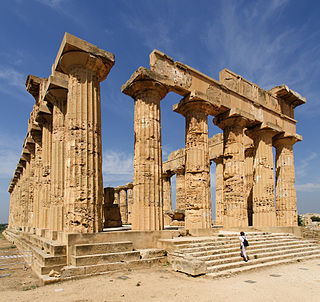
Selinunte was an ancient Greek city on the south-western coast of Sicily in Italy. It was situated between the valleys of the Cottone and Modione rivers. It now lies in the comune Castelvetrano, between the frazioni of Triscina di Selinunte in the west and Marinella di Selinunte in the east. The archaeological site contains five temples centered on an acropolis. Of the five temples, only the Temple of Hera, also known as "Temple E", has been re-erected. At its peak before 409 BC the city may have contained up to 30,000 people, excluding slaves.

Ancient Greek architecture came from the Greek-speaking people whose culture flourished on the Greek mainland, the Peloponnese, the Aegean Islands, and in colonies in Anatolia and Italy for a period from about 900 BC until the 1st century AD, with the earliest remaining architectural works dating from around 600 BC.

The Minoan civilization was a Bronze Age Aegean civilization on the island of Crete and other Aegean Islands, whose earliest beginnings were from c. 3500 BC, with the complex urban "civilization" beginning around 2000 BC, and then declining from c. 1450 BC until it ended around 1100 BC, during the early Greek Dark Ages. It represents the first advanced civilization in Europe, leaving behind a number of massive building complexes, sophisticated art, and writing systems. Its economy benefited from a network of trade around much of the Mediterranean.
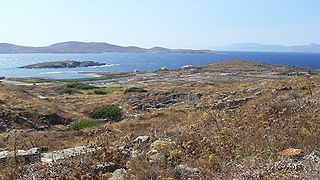
The island of Delos, near Mykonos, near the centre of the Cyclades archipelago, is one of the most important mythological, historical, and archaeological sites in Greece. The excavations in the island are among the most extensive in the Mediterranean; ongoing work takes place under the direction of the Ephorate of Antiquities of Cyclades, and many of the artifacts found are on display at the Archaeological Museum of Delos and the National Archaeological Museum of Athens.
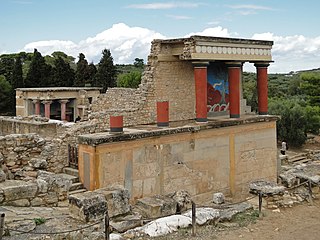
Knossos is the largest Bronze Age archaeological site on Crete and has been called Europe's oldest city.
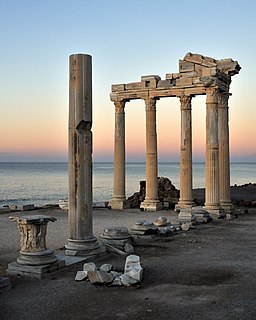
Side is a city on the southern Mediterranean coast of Turkey. It includes the modern resort town and the ruins of the ancient city of Side, one of the best-known classical sites in the country. It lies near Manavgat and the village of Selimiye, 78 km from Antalya in the province of Antalya.

Tiryns or is a Mycenaean archaeological site in Argolis in the Peloponnese, and the location from which mythical hero Heracles performed his Twelve Labours.

Glanum was an ancient and wealthy city which still enjoys a magnificent setting below a gorge on the flanks of the Alpilles mountains. It is located about one kilometre south of the town of Saint-Rémy-de-Provence.

Didyma was an ancient Greek sanctuary on the coast of Ionia in the domain of the famous city of Miletus. Apollo was the main deity of the sanctuary of Didyma, also called Didymaion. But it was home to both of the temples dedicated to the twins Apollo and Artemis. Other deities were also honoured within the sanctuary. The Didymaion was well renowned in antiquity because of its famed oracle. This oracle of Apollo was situated within what was, and is, the one of the world's greatest temples to Apollo. The remains of this Hellenistic temple belong to the best preserved temples of classical antiquity. Besides this temple other buildings existed within the sanctuary which have been rediscovered recently; a Greek theatre and the foundations of the above-mentioned Hellenistic temple of Artemis, to name but two.

Helladic chronology is a relative dating system used in archaeology and art history. It complements the Minoan chronology scheme devised by Sir Arthur Evans for the categorisation of Bronze Age artefacts from the Minoan civilization within a historical framework. Whereas Minoan chronology is specific to Crete, the cultural and geographical scope of Helladic chronology is mainland Greece during the same timespan (c.3200–c.1050). Similarly, a Cycladic chronology system is used for artifacts found in the Aegean islands. Archaeological evidence has shown that, broadly, civilisation developed concurrently across the whole region and so the three schemes complement each other chronologically. They are grouped together as "Aegean" in terms such as Aegean art and, rather more controversially, Aegean civilization.
A distinction is made between Greek gardens, made in ancient Greece, and Hellenistic gardens, made under the influence of Greek culture in late classical times. Little is known about either.

The Heraion of Samos was a large sanctuary to the goddess Hera, on the island of Samos, Greece, 6 km southwest of the ancient city of Samos, in the low, marshy basin of the Imbrasos river, near where it enters the sea. The late Archaic temple in the sanctuary was the first of the gigantic free-standing Ionic temples, but its predecessors at this site reached back to the Geometric Period of the 8th century BC, or earlier. The site of temple's ruins, with its sole standing column, was designated a joint UNESCO World Heritage Site, along with the nearby Pythagoreion in 1992.

Hierapolis was an ancient Greek city located on hot springs in classical Phrygia in southwestern Anatolia. Its ruins are adjacent to modern Pamukkale in Turkey and currently comprise an archaeological museum. The site has the Tomb of Philip the Apostle.
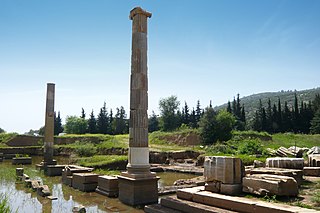
Claros was an ancient Greek sanctuary on the coast of Ionia. It contained a temple and oracle of Apollo, honored here as Apollo Clarius. It was located in the territory of Colophon, which lay twelve kilometers to the north, one of the twelve cities of the Ionian League. The coastal city Notion lay two kilometers to the south. The ruins of the sanctuary are now found north of the modern town Ahmetbeyli in the Menderes district of Izmir Province, Turkey.
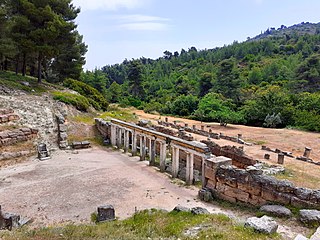
The Amphiareion of Oropos, situated in the hills 6 km southeast of the fortified port of Oropos, was a sanctuary dedicated in the late 5th century BCE to the hero Amphiaraos, where pilgrims went to seek oracular responses and healing. It became particularly successful during the 4th century BCE, to judge from the intensive building at the site. The hero Amphiaraos was a descendant of the seer Melampos and initially refused to participate in the attack on Thebes because he could foresee that it would be a disaster. In some versions of the myth, the earth opens and swallows the chariot of Amphiaraos, transforming him into a chthonic hero. Today the site is found east of the modern town Markopoulo Oropou in the Oropos municipality of Attica, Greece

The Temple of Hera, or Heraion, is an ancient Archaic Greek temple at Olympia, Greece, that was dedicated to Hera, queen of the Greek Gods. It was the oldest temple at Olympia and one of the most venerable in all Greece. It was originally a joint temple of Hera and Zeus, chief of the gods, until a separate temple was built for him. It is at the altar of this temple, which is oriented east-west, that the Olympic flame is lit and carried to all parts of the world. The torch of the Olympic flame is lit in its ruins to this day. The temple was built in approximately 590 BC, but was destroyed by an earthquake in the early 4th century CE.

The Temple of Asclepius was a sanctuary in Epidaurus dedicated to Asclepius. It was the main holy site of Asclepius. The sanctuary at Epidaurus was the rival of such major cult sites as the Sanctuary of Zeus at Olympia and Apollo at Delphi. The temple was built in the early 4th century BC. If still in use by the 4th century AD, the temple would have been closed during the persecution of pagans in the late Roman Empire, when the Christian Emperors issued edicts prohibiting non-Christian worship.

Azoria is an archaeological site on a double-peaked hill overlooking the Gulf of Mirabello in eastern Crete in the Greek Aegean. "Azoria" is a local toponym, not apparently an ancient place name or epigraphically-attested Greek city.
The religious element is difficult to identify in Mycenaean Greece, especially as regards archaeological sites, where it remains very problematic to pick out a place of worship with certainty. John Chadwick points out that at least six centuries lie between the earliest presence of Proto-Greek speakers in Hellas and the earliest inscriptions in the Mycenaean script known as Linear B, during which concepts and practices will have fused with indigenous Pre-Greek beliefs, and—if cultural influences in material culture reflect influences in religious beliefs—with Minoan religion. As for these texts, the few lists of offerings that give names of gods as recipients of goods reveal nothing about religious practices, and there is no other surviving literature.
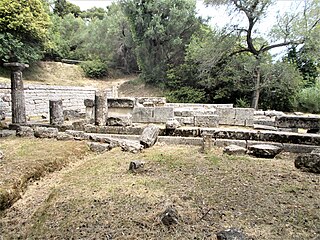
Kardaki Temple is an Archaic Doric temple in Corfu, Greece, built around 500 BC in the ancient city of Korkyra, in what is known today as the location Kardaki in the hill of Analipsi in Corfu. The temple features several architectural peculiarities that point to a Doric origin. The temple at Kardaki is unusual because it has no frieze, following perhaps architectural tendencies of Sicilian temples. It is considered to be the only Greek temple of Doric architecture that does not have a frieze. The spacing of the temple columns has been described as "abnormally wide". The temple also lacked both porch and adyton, and the lack of a triglyph and metope frieze may be indicative of Ionian influence. The temple at Kardaki is considered an important and to a certain degree mysterious topic on the subject of early ancient Greek architecture. Its association with the worship of Apollo or Poseidon has not been established.






















